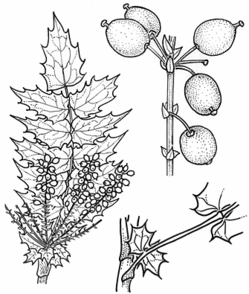Common name: Oregon Grape, Mountain Grape, Oregon Barberry, Oregon Grapeholly, Jaundice Berry, Woodsour, Sowberry, Pepperidge Bush, Sourspine, Tall Oregon Grape
Berberis aquifolium Pursh APNI* Synonyms: Mahonia aquifolium (Pursh) Nutt. APNI*
Mahonia leschenaultii auct. non (Wight & Arn.) Takeda APNI*
Mahonia pinnata auct. non (Lag.) Fedde APNI*

Description: Evergreen shrub to 4 m high; stems without spines.
Leaves articulated, imparipinnate, mostly 15–40 cm long, borne on short shoots; leaflets (3–) 11–19 with basal pair often smaller and ± stipule-like; leaflets ± ovate, 3–8 (-14) cm long, 1–4 (–6) cm wide, glabrous, margins coarsely toothed, teeth spinose; petiole dilated at base.
Racemes 3–19 cm long, in clusters of c. 3–20 at the ends of shoots; pedicels to 10 mm long. Flowers 7–12 mm diam., yellow.
Berry ± globose, 6–9 mm long, pruinose blue to bluish black, persistent style c.1 mm long.
Flowering: spring.
Distribution and occurrence: often cultivated as an ornamental, occasionally naturalised, including gullies in the Blue Mountains and disturbed sites in the Southern Highlands. Native to western North America. Naturalised plants have been recorded growing on roadsides, in paddocks, pine plantations, disturbed sclerophyll forest or woodland, rainforest, riverbank scrub.
NSW subdivisions: *NC, *CT, *ST, *SWS
Other Australian states: *Vic. *S.A.
The names Berberis leschenaultii Wight & Arn., Mahonia leschenaultii (Wight & Arn.) Takeda ex Dunn, B. pinnata Lag. and M. pinnata (Lag.) Fedde have previously been misapplied to Berberis aquifolium Pursh in Australia. The species name 'aquifolium' means 'holly-leaved', referring to the spiny foliage.
Text by G.J. Harden (Flora of NSW 1: 169, 1990), as Mahonia leschenaultii; updated April 2017, P.G. Kodela
Taxon concept: Australian Plant Census (CHAH 2010; accessed April 2017)
APNI* Provides a link to the Australian Plant Name Index (hosted by the Australian National Botanic Gardens) for comprehensive bibliographic data
***The AVH map option provides a detailed interactive Australia wide distribution map drawn from collections held by all major Australian herbaria participating in the Australian Virtual Herbarium project.
|


